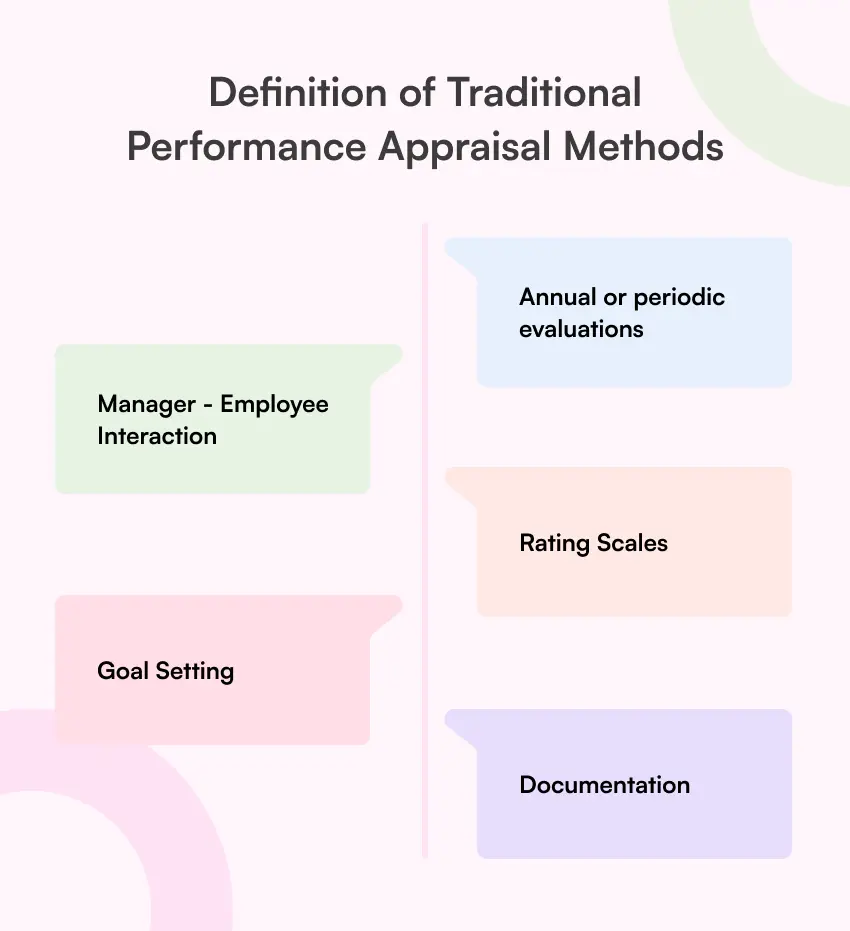
10 Best Traditional Performance Appraisal Methods In HRM
Table of Contents
Performance appraisal methods are an essential component of every organization’s HR administration. These appraisals assist in measuring an employee’s performance against predetermined objectives and standards, as well as assessing their prospective potential contributions to the company. The majority of businesses have utilized traditional performance appraisal methods since the dawn of time, and many companies continue to employ them now.
The traditional method of performance appraisal consists of an executive or manager evaluating an employee’s performance. This could entail reviewing measures like logs of attendance, performance measurements, achieving objectives and targets, client feedback surveys, and so on. Each traditional method has pros and cons that ought to be considered when determining which method will work most suitable for the company’s needs.
What Is A Performance Appraisal?
A performance appraisal is a structured and recurring procedure that compares a worker’s job performance to the work’s defined demands. It is an unbiased assessment of an employee’s abilities and constraints, how important they are to the company, and future growth possibilities.

This typically occurs once or twice annually, at the beginning of the calendar year, and close to the halfway mark. These are official meetings in which the immediate manager or superior examines the employee’s progress on the primary duties and tasks at hand. HR is often in charge of designing the performance appraisal procedure, which managers subsequently carry out. Employees’ involvement in the process generates the buy-in required to implement the changes that the performance appraisal was designed for in the first instance.
10 Best Traditional Methods Of Performance Appraisal In HRM
Ranking Method
It is the first and easiest formalized structured traditional method of performance appraisal in which a single employee is contrasted to all others with the goal of determining their relative worth. Employees are given ratings from highest to lowest, or from best to worst.
This identifies the employee with the highest and lowest rating on the quality that is being evaluated. Then, among the subsequent highest and lowest, rank the next best and worst employees. Thus, if there are a total of ten employees to be evaluated, there are going to be 10 ranks ranging from one to ten.
Paired Comparison Method
Using this performance appraisal traditional method, every employee contrasts every characteristic with all other employees in pairs, one at a time. This strategy makes assessment less difficult and more straightforward than the traditional ranking system. The number of times someone is contrasted with another individual is recorded on paper. These numbers produce the rank number for each pair. This approach traditionally uses a paper-based evaluation form to assess each employee, although in more recent years digital alternatives such as flipbooks are more common.
The findings are compiled and each person is granted a rank. The rater considers the individual with the highest points to be the most significant employee, while the one with no points is viewed as the one with the least worth. This strategy is unsuitable for huge businesses.
Checklist Method
The checklist approach ranks as one of the most straightforward traditional performance appraisal methods. Under this conventional method of performance review, HR creates a checklist and sends it to the management. The checklist might contain a set of questions (about employee conduct and work performance), to which the manager must respond with a simple ‘YES’ or ‘NO’.
The management evaluates the question and the employee and responds based on their assessment of the employee. Questions in the checklist are assigned a number score depending on how crucial they are to work efficiency. As a result, the appraisal grade is derived by summing the ratings for all of these distinct elements.
Confidential Report Method
This is a traditional method of appraisal in HRM, yet it is not commonly used in private companies. This method is most commonly used in appraisals conducted by public or confidential bodies. The confidential report system, as the name implies, entails delivering the employee’s appraisal to senior-level executives in closed envelopes.
These envelopes offer details about how they performed throughout a specific time period. The confidential report system assures that employees do not view their ratings or forecast their future progressive development changes. Because of its clandestine character, this practice is unlikely to boost employee efficiency.
Critical Incidents Method
This employee traditional method of performance appraisal in HRM concentrates on core behaviors that influence how the work is performed. Critical events are those that have either a beneficial or detrimental effect on how a work responsibility is done. The method begins by defining particular habits that impact the work setting. A group of human resources professionals then begins assigning value to these specific behavioral events.
The next thing to do is to create a checklist. The ‘rater’ selects and stamps whether the employee’s individual behavior is positive or negative. The idea underlying this strategy is to outline uncommon behavior. The hypothesis holds that pursuant to normal conditions, employees with the exact same knowledge base should produce the exact same outcomes.
Essay Appraisal Method
This method of traditional performance appraisal, frequently referred to as the “Free Form method,” consists of an explanation of an employee’s performance by their boss. The summary is an appraisal of a person’s achievements according to data, and it often features instances and proof to back up what is stated.
One major disadvantage of the process is that the evaluator’s subjectivity cannot be separated. Under this approach, the rater is expected to convey both the strengths and weaknesses of the employee’s conduct. This method is usually employed in conjunction with a graphical scale for rating since the rater can comment on the scale by providing a context for their evaluation.
Force Distribution Method
This traditional method of performance appraisal in HRM was prevalent in big businesses. It relies on the notion that staff efficiency varies widely within a company, with certain individuals being highly efficient while others are less effective.
In this approach, the management is required to disperse employees based on how they perform across every aspect of the bell-shaped curve. Some are in the excellent range, while others are mediocre or at the bottom portion of the curving scale. The primary flaw in this approach is the belief that staff performance levels consistently adhere to a standard distribution.
Graphic Rating Scale Method
The graphic scale of ratings serves as one of the most common and traditional methods for performance appraisal. It is additionally known to be a linear rating system. This approach uses a paper-based evaluation form to assess each employee. The form includes features like dependability and excellence, as well as work performance attributes ranging from poor to excellent for each characteristic.
The rating is based on the points on the spectrum. A five-point scale is most commonly used. The rater values each appraisee by selecting the rating that most accurately characterizes employee performance for each of the characteristics. Finally, all allocated characteristic scores are tallied.
Grading Method
In this performance appraisal traditional method in HRM, specific types of merit are predetermined and precisely specified. Employees can be classified into the following groups: excellent, satisfactory, and unsatisfactory. There could be three more levels. Employee performance is evaluated against grade standards.
The individual is then assigned to the rating that most closely matches their performance. This sort of rating is used in an annual evaluation pattern and when selecting candidates in the broader domain. One of the primary disadvantages of this approach is that the assessor can assess the majority of employees on the top end of their job performance.
Field Review Method
When there is cause to worry about a rater’s prejudice or when their score seems to be substantially higher than others, this is balanced through a review procedure. The hiring manager in the human resources department normally conducts the review procedure.
The evaluation process includes the following actions: a) Determine areas where there is an inter-rater dispute, b) assist the team in reaching a consensus, and c) confirm that each rater is aware of the norm likeness. However, the method is time-consuming. Managers often dislike the way they perceive staff influence. As a result, the approach is rarely used.
Conclusion
Performance appraisal methods have been regarded as the most important and vital strategy for a business, as the knowledge it gives is quite beneficial in making decisions about many individual facets of the work environment. The performance appraisal process is quite delicate. It has a highly beneficial outcome if the procedure is followed in an organized way.
The very same procedure might potentially result in the utter demise of the whole work environment if necessary precautions aren’t taken during the employee review process. Each type of traditional performance appraisal method has advantages and disadvantages that may be appropriate for a particular company but ineffective for others. As a result, no particular assessment approach is regarded as valid and employed by all companies to evaluate their employees’ performance.



















